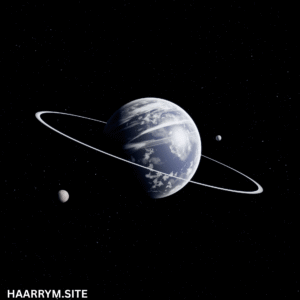Among the most fascinating issues in astronomy and space science is the circling solar system. From the smallest asteroid to the biggest gas giant, every thing in our solar system follows a designated course, or orbit, around the Sun. For millennia, physicists and astronomers have been enthralled by its orbital motion, which is controlled by the rules of physics mostly including gravity and inertia.
The meaning of the “orbiting solar system,” how planetary orbits work, what variables affect these orbits, and the general relevance of orbital mechanics in our knowledge of space will be discussed in this paper.
Meaning of “Orbiting Solar System”?
The phrase “orbiting solar system” describes, via gravitational forces, the constant, predictable motion of planets, moons, asteroids, and comets around the Sun. Simply said, it’s the motion of everything in our solar neighborhood across space.
Every planet follows an elliptical route around the Sun, hence determining the rather oval-shaped orbit. The basic ideas of physics—especially Kepler’s Laws of Planetary Motion and Newton’s Law of Universal Gravitation—rule this movement; it is not random.
Orbits’ Fundamentals
An orbit is the curved trajectory an object travels around a star, planet, or moon. Every planet in our solar system revolves around the primary, most massive object—the Sun. It works like this:
-
The planets are drawn toward the Sun by its mass.
-
The planets’ inertia—that is, their inclination to keep traveling in a straight line—keeps them from slamming into the Sun.
The outcome is a balance between these forces that produces an orbit around the Sun on a steady route.
Every orbit is unique. Some are somewhat elliptical; others are almost round. The mass of the object, its distance from the Sun, and gravitational effects from other celestial bodies determine these variances.
Laws of Kepler and the Orbiting Solar System
The Laws of Johannes Kepler help to clearly describe the behavior of the circling solar system:
1. Ellipsesian Law
With the Sun at one of the two foci, every planet revolves in an elliptical path.
2. Equilibrium Area Law
A line linking a planet to the Sun sweeps out equal regions over equal times. Planets hence travel quicker toward the Sun and slower further away from the Sun.
3. Harmonic Law of Law
The cube of a planet’s mean distance from the Sun determines its square of an orbital period. This clarifies the reason inner planets such as Mercury orbit faster than outer planets such as Neptune:
Newton’s Approach to Orbiting
Isaac Newton addressed the why while Kepler detailed the manner of planetary orbits. Every thing in the cosmos attracts every other object with a force determined by their masses and distance apart per Newton’s Law of Universal Gravitation.
The invisible thread holding planets in their orbits close to the Sun tied is gravitational pull. Newton’s work defined how the circling solar system functions and set the basis for classical mechanics.
The Part Gravity Plays in Orbiting Bodies
All orbital movement is driven mostly by gravity. The great gravitational force of the Sun maintains every planet in its proper course. Analogous gravitational forces of planets affect the orbits of satellites, moons, and surrounding space trash.
Planets would migrate in straight lines out into space without gravity. Their fall directly into the Sun would be without inertia. Orbital motion is the outcome of the ideal equilibrium between these two forces.
Planets: Orbital Features of Solar System Bodies
Considered the ecliptic plane, all eight planets circle the Sun in the same direction and nearly the same plane. Their roughly circular but eccentric orbits help to provide solar system stability.
Two moons.
Moons round planets, which then round the Sun. The gravity of the planet determines these secondary orbits; they may be either regular (circular, steady) or irregular (quite elliptical, unstable).
Three: Comets and asteroids
Mostly orbiting in the asteroid belt between Mars and Jupiter, are asteroids. Comets have more eccentric orbits that bring them from the solar system’s furthest points toward the inner regions near the Sun.
Gravitational Interaction and Orbital Resonance
Certain celestial bodies are in orbital resonance, that is to say, their orbits are connected such that they regularly, periodically affect one another with regard to gravity. One well-known instance is the 2:3 resonance between Neptune and Pluto—every time Neptune finishes three revolutions around the Sun, Pluto finishes two.
Over time these interactions may either stabilize or destabilize orbits. Even setting smaller objects on collision paths or ejecting them from the solar system altogether, gravitational pulls from large giants like Jupiter may alter the orbit of smaller things.
Human Comprehensibility and Space Projects
Planning and carrying out space missions depend much on an awareness of the circling solar system. To get to their targets, satellites, space probes, and rovers depend on exact orbital mechanics computations.
As a matter of fact:
-
To go faster and further, NASA’s Voyager spacecraft used slingshots—or planetary gravity aids.
-
Placed at a Lagrange Point—a region where gravitational forces balance—the James Webb Space Telescope was kept in a stable orbit using little fuel.
Our growing understanding of orbital dynamics helps us to more safely and effectively explore space.
The Evolution of Orbits Through Time
Solar system orbits are not set eternally. Their modification may result from many elements:
-
Gravitational disturbances from other planets
-
Runs-through collisions with other space objects
-
Tidal powers
-
Mass lost from stars and planets
Though often gradual, over millions or billions of years these changes may have major impact. For example, gravitational interactions and Sun-induced relativity effects are progressively changing Mercury’s orbit.
Why the Orbiting Solar System Matters
Understanding the circling solar system helps us to grasp our position in the cosmos as much as it advances astronomy. Here’s the significance:
-
Predicting celestial occurrences depends on our knowledge of orbits for e-clipses, meteor showers, and planetary alignment.
-
Tracking near-Earth objects lets one find possible asteroid hazards for Earth.
-
Navigating space missions calls for orbital computations.
-
Operating based on orbital concepts, satellite networks like GPS and weather satellites represent developing technology.
Last Notes
One dynamic and precisely balanced system is the circling solar system. From the orderly motions of planets to the erratic trajectories of comets, every celestial body follows the rules of physics that have been investigated and polished over millennia. Understanding these orbits not only deepens our knowledge of the cosmos but also helps us to use that information to advance life on Earth and future exploration beyond it.
Whether your interests are space, astronomy, or just inquisitive about how our solar system operates, understanding the principles of orbits provides a great window into the cosmic ballet performing just over our heads.

